Haunted Nevada
Summer 2020
The Nevada State Prison in Carson City has a hauntingly extensive history.
BY MEGG MUELLER AND ERIC CACHINERO
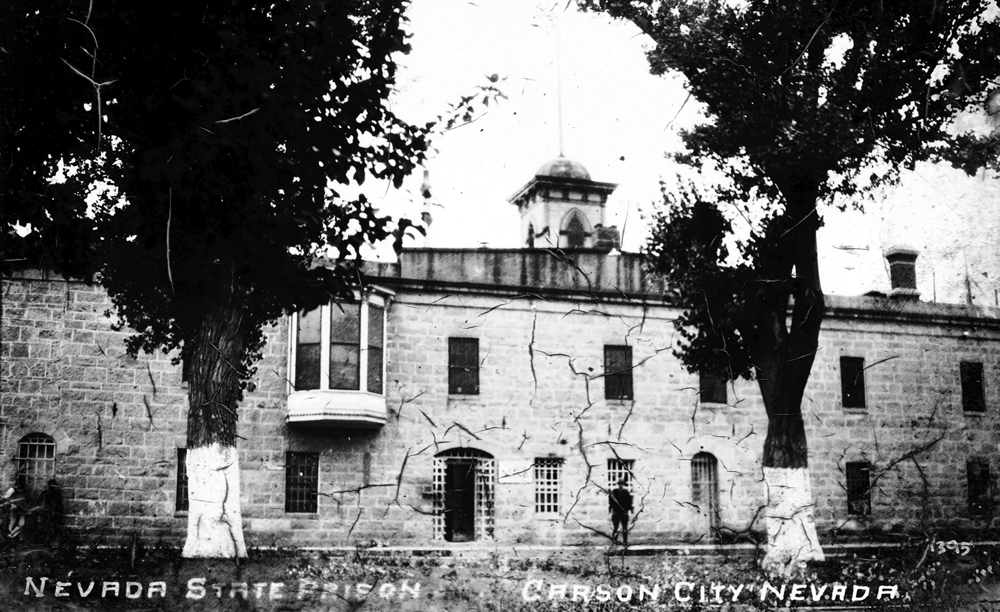
With an arsenal of abandoned historical buildings and eerie locations, Nevada can be spooky occasionally. Much of the energy stems from the state’s mining history, which got grizzly and dark at times. Mine fires and construction catastrophes are engrained in Nevada, as are Wild West-style murders. Some people attribute these factors to the reported hauntings at many of the state’s oldest mines and buildings.
Not everything paranormal needs to be scary, though. Many people believe in the presence of residents past, whose ties to a particular area will simply withstand the test of time.
Whether you believe in ghosts or not, there’s a strong case to be made that different buildings or areas can affect our senses in different ways. This certainly has been the case with myriad paranormal investigators that have spent countless hours in the Silver State searching for something spectral.
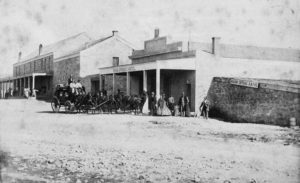
A HISTORICAL LOOK
The phrase “if these walls could talk” is bandied about to convey that a room or structure had likely housed many conversations and situations that had been forgotten in the shadows of time. Nowhere could this be truer than the Nevada State Prison in Carson City. The stories that remain from the venerable institution are enough to fill 10 libraries, and consider this: those are just the ones we know about.
For 150 years—starting before Nevada was even a state—the prison played a significant role in the history of Nevada. Not only did it protect the state’s residents, but it influenced the architecture, and was home to a long list of historically significant, albeit not always pleasant, events.

In December 1861, Nevada’s first territorial legislature met at Abraham Curry’s Warm Springs Hotel in Carson City and authorized the creation of the board of prison commissioners. Not wasting any time, the board leased property adjacent to Curry’s hotel on Jan. 1, 1862, for the new prison and Curry was appointed the first territorial warden.
Twice—in 1867 and 1870—the prison burned down and was eventually replaced by some of the sandstone buildings still standing today. The sandstone came from the prison’s own quarry and ended up being used in some of the area’s most prestigious buildings, including the Capitol and the Carson City Mint. The quarry turned out to be home to many fossils and fossilized tracks that were revealed as the sandstone was cut away. Mammoth, bison, horse, deer, wolf, and big tooth cat tracks all were found, as were those of a giant sloth that, for a time, were said to be the footprints of giant men.
The prison had its share of sensational events, including a mass escape of 29 prisoners in 1871, and the odd events surrounding Lieutenant Governor Frank Denver, who in 1873, refused to relinquish the position of warden until the Governor called out the militia. It took 60 soldiers and some artillery to convince him to open the prison gates to the new warden.
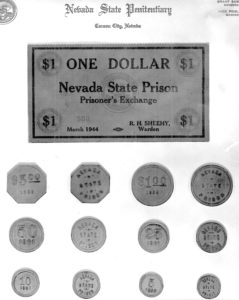
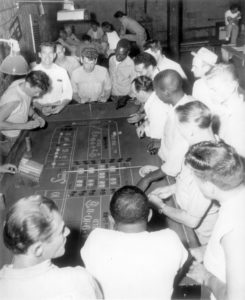
The prison also was home to the only penal casino known in the U.S. From 1932 to 1967, inmates were allowed to gamble at table games, even spawning a currency coined by the prison. Brass coins of $1, $5, half-dollars, quarters, dimes, and nickels were made and used until the prison shut down.
Executions were a part of the prison’s history, with the first one occurring on Sept. 8, 1905, and the first and only inmate to be executed by firing squad died in 1910. The first person executed in a gas chamber happened at the prison in 1924, although it took two grisly attempts to get the new method to work. Lethal injection became the standard in 1985 until Nevada’s last execution in 2006. The prison housed Nevada’s only execution chamber until the Ely State Prison’s opened in 2016.
On May 12, 2012, the prison closed, but today, work is underway to make this landmark a historical destination where the past will be interpreted through exhibits, tours, and lectures. The Nevada State Prison Preservation Society is the nonprofit organization leading the effort and working to ready the building for visitors, hopefully in 2020. —Megg Mueller
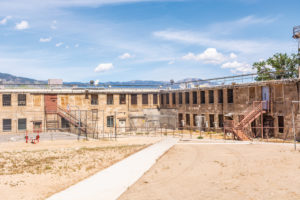
A SPECTRAL LOOK
In June, Megg and I visited the historic Nevada State Prison for a tour. Having driven past the building hundreds of times but never having entered, I was looking forward to seeing it from the inside. The prison has been the subject of many a haunting story over the years, and was even the subject of the Travel Channel paranormal investigative show “Ghost Adventures” in 2016. We were joined on the tour by Nevada State Prison Preservation Society Vice President Maurice White, former Nevada State Prison Corrections Officer Dennis Williams, and Paranormal Investigator Susan Bernard.
When viewed through a historical lens, the prison is fascinating. So many inmates and so much history happened inside the walls. When viewed through a haunted lens, though, the prison takes on a much more sinister feel.
Our tour starts with a brief look at the exterior of the building before heading inside. In the main courtyard, one can only imagine what living inside the walls must have felt like. The uniform sandstone blocks and concrete that compose much of the courtyard look strange when paired with the natural stone walls and crude caves that are intermixed. Barbed wire and metal bars cover most surfaces. Basketball hoops and barbells still line the yard, as does the chipping concrete foundation that once housed the prison’s onsite casino. Everything looks eerily bleak.

Once inside, this dullness is briefly offset—though only on the surface. In the visiting room—designed to make children and family members feel comfortable while visiting inmates—is a violently vibrant mural featuring familiar cartoon characters, which we’re told was painted by one of the most notorious serial killers in Nevada’s history.

From there we tour the cells blocks, which still bear the scratchings of inmates on the walls—some written in pencil counting down the days, some scratched in the walls reminiscing on old lovers, some with messages to religious figures written in toothpaste. The sun makes a mediocre attempt to penetrate the opaque windows and find its way into the cells, though most have an eerie darkness to them.
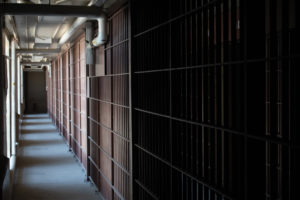
After the cell blocks, we travel to the most surreal part of the tour: the gas chamber. From 1924-1979, more than 30 death-row inmates were executed using lethal gas in the on-site gas chamber, and dozens more using lethal injection. Prior to the first execution by lethal gas (the first facility in the country to do so), the preferred method was hanging.
The room truly looks like something out of “The Twilight Zone.” A solitary mattress covered in leather restraints sits idly in a bowl-shaped room, complete with observation windows that are eerily reminiscent to a fishbowl. One can only imagine what those last moments must have felt like.

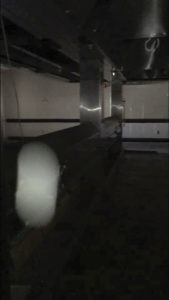
Our tour concludes with a visit to the cafeteria, which gives off a similarly eerie vibe. Before leaving, we’re strongly cautioned by our tour guides to confidently tell any lingering ghosts to stay at the prison and not follow us home.
Upon later reviewing my audio recordings from inside the prison, I caught something interesting. During one segment, as our voices echoed from the concrete walls, there seemed to be an additional gravelly voice—not belonging to anyone on our tour—that says, “Get out of here.”
Here is the audio…Take a listen for yourself and let us know what you think. —Eric Cachinero

